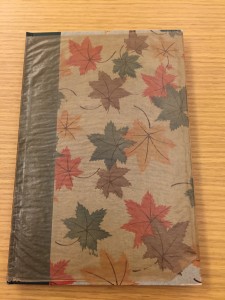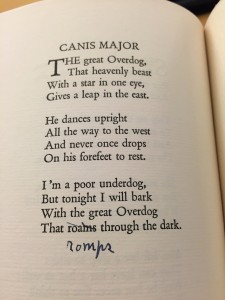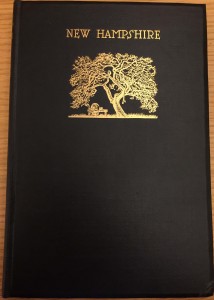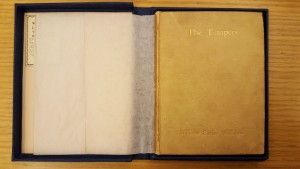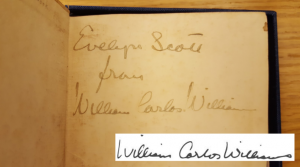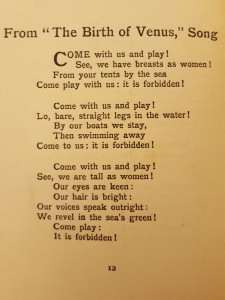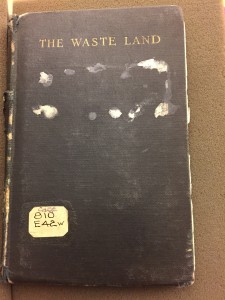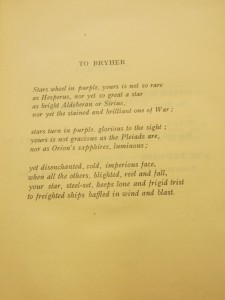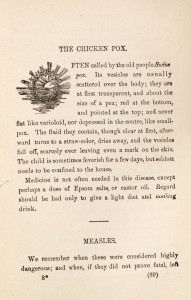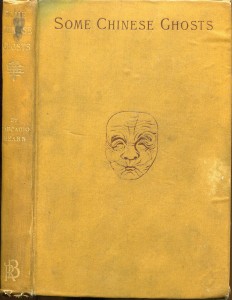[Posted by Bridget Reilly for ENG 812 Modern Poetry, Professor Rosen]
 Wallace Stevens’ Esthétique du Mal was published in July 1945. Holly Stevens, the poet’s daughter, gave the book to the Watkinson and it is one of 300 copies printed. The modestly sized book is made from luxurious materials that Stevens personally selected. The cover is decorated with vibrant blue Natsume straw-paper and the poem is printed on supple pace paper. Abstract illustrations by Wightman Williams accompany the poem.
Wallace Stevens’ Esthétique du Mal was published in July 1945. Holly Stevens, the poet’s daughter, gave the book to the Watkinson and it is one of 300 copies printed. The modestly sized book is made from luxurious materials that Stevens personally selected. The cover is decorated with vibrant blue Natsume straw-paper and the poem is printed on supple pace paper. Abstract illustrations by Wightman Williams accompany the poem. 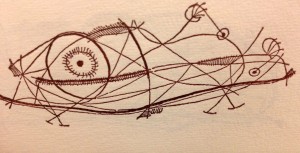 George Dillon, the critic who reviewed the book when it was first published, likened Williams’ designs to the “marginal doodlings of his satanic majesty” (97). Dillon’s assessment seems an apt description of the bizarre illustrations. However, the drawings and the fine materials Stevens selected make the book a visually interesting object. Dillon admitted that the book was an artistic achievement and called it “a blue phenomenon” (97). He writes, “his [Stevens’] new long poem […] has been made into something which belongs to the décor of opulence” (97).
George Dillon, the critic who reviewed the book when it was first published, likened Williams’ designs to the “marginal doodlings of his satanic majesty” (97). Dillon’s assessment seems an apt description of the bizarre illustrations. However, the drawings and the fine materials Stevens selected make the book a visually interesting object. Dillon admitted that the book was an artistic achievement and called it “a blue phenomenon” (97). He writes, “his [Stevens’] new long poem […] has been made into something which belongs to the décor of opulence” (97).
Stevens, no doubt, would have been pleased by Dillon’s assessment. His 1945 correspondence reveals that he was deeply concerned with how the book would look and function, not poetically, but as a physical art object. Between June and November, Stevens wrote three times to his friend and multimedia artist James Guthrie. In each letter, all of which can be found at the Watkinson, Stevens talks almost exclusively about the book, its materials, its design, and the process of its printing. In his responses to Stevens’ letters, Guthrie attempts to open up the discussion and talk about current events and his own poetic endeavors, but Stevens always directs the conversation back to Esthétique du Mal. It seems that for the good portion of 1945, the book’s production was one of Stevens’ main interests, and, at times, the cause of great stress.
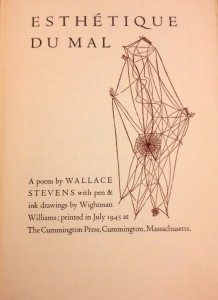 However, in June, Stevens writes optimistically about Cummington Press, the small boutique printer he was working with. He informs Guthrie that the press is “really the work of not that much more than one man [Harry Duncan],” and his partner Wightman Williams (the books illustrator). He explains that the work they do is “quite extraordinary” (June 25 1945).
However, in June, Stevens writes optimistically about Cummington Press, the small boutique printer he was working with. He informs Guthrie that the press is “really the work of not that much more than one man [Harry Duncan],” and his partner Wightman Williams (the books illustrator). He explains that the work they do is “quite extraordinary” (June 25 1945).
By October, Stevens was still certain that the book’s printing job “definitely add[ed] to the text.” However, in his letters, Stevens seems less happy with the book and the press. He mentions to Guthrie that he is weary about Duncan’s and Williams’ desire to “use color to some extent” in the poem’s text. Stevens downplays his reluctance to Guthrie, but in a letter to Duncan, Stevens does not hold back. Stevens explains, “I cannot think of a decent book that I have in which the text is printed in colored ink, and I am strongly against it. However, I leave the make of the book to you” (Cummington Press Correspondence10). Not surprisingly, the poem was printed in black ink.
In addition to questioning Duncan’s and Williams’ creative sensibilities, Stevens was also displeased with the delay of the book’s publication. He explains to Guthrie that the book’s production is behind schedule and that the press “feels victimized.” Considering the technology Duncan and Williams were dealing with and the bullying tone Stevens often took with them, perhaps the pair had good reason for feeling that way. The hand-press, which “was operated manually by two people and resembled the press that Gutenberg invented,” could only work on cool days with high humidity (NewYorkTimesObit). This made printing mostly seasonal and not nearly as efficient as the high-powered executive poet would like it to be. In addition, because of World War II the press continuously experienced paper shortages. At one point, Duncan and Williams had to use Pink straw-paper for the cover instead of the blue Stevens had selected. As one can imagine, Stevens was not pleased. For Stevens, neither the war nor technological glitches seemed good reasons for the delay of the book’s printing. He writes to Guthrie that the book really “ought to have been published by this time” (Oct 18 1945).
Based on his correspondence, it is clear that Stevens spent a lot of time thinking about the book’s production and its appearance. Indeed, as far as Esthétique du Mal was concerned, Stevens was as much, if not more, interested in how the booked looked as he was with the poetry it contained. When the book was finally finished in November, four months after publication date written on the title page, Stevens sent a copy to good old Guthrie. In his letter he writes, “I shall be interested to know what you, yourself, think, not about the poetry, but about the book” (Nov 23 1945). Stevens’ preoccupation with the aesthetic appearance of this material object seems to give credence Robert Frost’s critique that Stevens was a poet of “bric-a-brac” (NewYorker). Admittedly, Stevens’ discussion of the book suggests that it can be seen as one of many beautiful objects that interested the insurance executive, who lived well and was unopposed to weaving images of material comfort into his poetry. When publishing Esthétique du Mal, Stevens insured that the book could fit seamlessly into the world he depicts in “Sunday Morning.” Indeed, we can picture it now: there is the woman in her “peignoir,” there is the green “cockatoo/ upon the rug,” and there is the blue phenomenon lying casually on the drawing room table.
Works Cited
Dillon, Geroge. “A Blue Phenomenon: Esthétique du Mal by Wallace Stevens, Wightman Williams.” Poetry 68.2 (1946): 97-100. Print.
Masel, Carolyn, ed. “Stevens, Wallace. Wallace Stevens-Cummington Press Correspondence, 1941-1951.” Libraries of the University of Missouri: Special Collections and Rare Books. N.p., n.d. Web. 4 May 2016. <http://library.missouri.edu/specialcollections/stevens-wallace-wallace-stevens-cummington-press-correspondence-1941-1951/>.
Pace, Eric. “Harry Duncan, 80, Hand Printer of Literary Works, Dies.” New York Times [New York] 23 Apr. 1997, Art.
Schjeldahl, Pater. “Insurance Man.” The New Yorker 2 May 2016.

